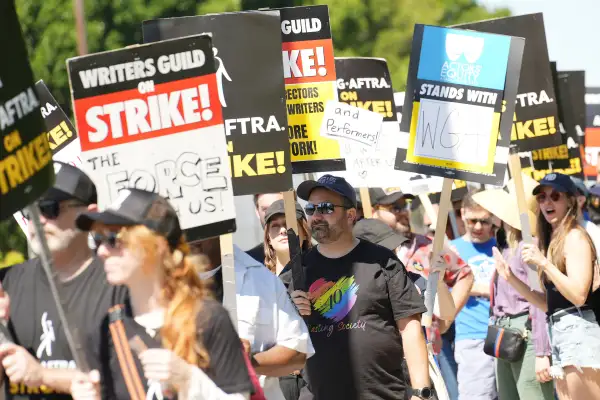Summer of Strikes: Why So Many Workers Are Walking off the Job

It’s official: We’re having a hot labor summer.
Urban Dictionary cemented the trend when it added the term to its website last Thursday, defining hot labor summer as “the summer where everyone from actors to fast food workers and even your mom either unionize their workplace or support their existing union by going on strike for better labor conditions.”
Something’s in the water right now: About 11,000 workers affiliated with the Writers Guild of America have been on strike since early May. Roughly 160,000 with SAG-AFTRA joined them on Friday, meaning that “almost every performer and writer is on strike for the first time in 63 years,” as the Washington Post put it. And about 330,000 UPS employees are prepared to stop work if their contract negotiations don’t shake out by the end of July, potentially throwing the nation’s package delivery system into chaos.
It’s a huge cultural event that seems to have escalated quickly. Why is everybody on strike all of a sudden?
Low unemployment during 'hot labor summer'
Paul Clark, a labor and employment relations professor at Penn State University, says strikes are having a moment because of a perfect storm of coinciding factors.
“For decades now, the labor movement in this country has been on the defensive — membership has been declining, bargaining power has been falling, and you've seen a significant decline in strikes because employers have had the upper hand,” he tells me. “But right now, [we’re] in the midst of a very unique situation that finds the labor movement all of a sudden on the offensive.”
Clark boils it down to a few main causes.
The first is the state of the economy. The latest numbers from the Bureau of Labor Statistics peg the current unemployment rate at 3.6%, which is pretty low by historical standards. The unemployment rate fell between 2010 (the aftermath of the Great Recession) and 2020 (the start of the COVID-19 pandemic), and now it’s back on the downswing.
Clark says that when unemployment is high, unions have a weakened ability to strike.
Basically, if a union strikes and a whole bunch of employees refuse to work, employers can easily find replacements because everyone’s looking for jobs. The employers aren’t really put out, their profits don’t suffer, and the action loses its teeth, which Clark says “sort of negates” the strike.
But when unemployment is low, like it is now, it’s a lot harder for employers to hire replacements because not as many people are looking for jobs. As such, employers get confronted with the fact that they won’t be able to continue operating their business — and they're going to start losing money if they don’t do something. Fast.
That “something” is often to raise wages or improve working conditions — the two major things WGA, SAG-AFTRA and UPS are pushing for.
Why the political climate is ripe for worker strikes
The second factor in the perfect storm of hot labor summer is President Joe Biden, who has said he wants to be “the most pro-union president you've ever seen.”
Clark says this bolsters unions, especially when it comes to the National Labor Relations Board, or NLRB. On Biden’s first day in office, he fired NLRB General Counsel Peter Robb and appointed Jennifer Abruzzo, kickstarting a ripple effect. Public support for unions is also at a six-decade high.
“Right now, labor law in this country is being interpreted consistently in the interest of unions, and the board is being very aggressive when employers violate our labor laws,” Clark adds.
This month alone, the NLRB found that Starbucks illegally fired four pro-union baristas in Pennsylvania, ruled that it illegally closed stores in New York without giving staff the chance to bargain and sued over its refusal to rehire 33 pro-union workers at locations in Washington. And that’s to say nothing of how the NLRB is cracking down on Amazon, which it said in a complaint last week has failed to bargain with the Amazon Labor Union for warehouse workers in New York.
Susan Schurman, distinguished professor of labor studies and employment relations at Rutgers University, says that our hot labor summer can also be traced back to the pandemic.
The nationwide lockdowns showed young workers in low-wage jobs — like those at grocery stores, coffee shops and shipping warehouses — that despite being generally considered unskilled labor, they are, in fact, essential.
“And yet they don’t get paid very much,” Schurman explains. Now that we’re on the other side of the pandemic, she adds, “there’s a whole generation of younger workers that are discovering unionization as the most reliable way to get better pay and working conditions.”
It’s not just Gen Z-ers who have higher expectations for how they’re treated at work. For the Hollywood strikers, there are also the threats of artificial intelligence and the rise of streaming to contend with.
Clark says the big question among experts, then, is whether we’re seeing a fundamental change to the American workplace or if hot labor summer is just a momentary shift because all of the above factors happened to line up together at once.
The answer?
“I think we’ll know if and when our economy starts to shift back into a recession mode,” he says.
More from Money:
55% of Workers Say They Haven't Gotten a Raise in Over a Year


